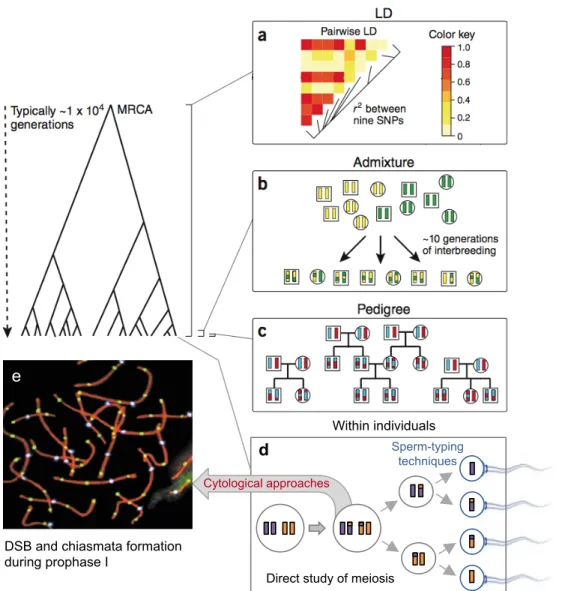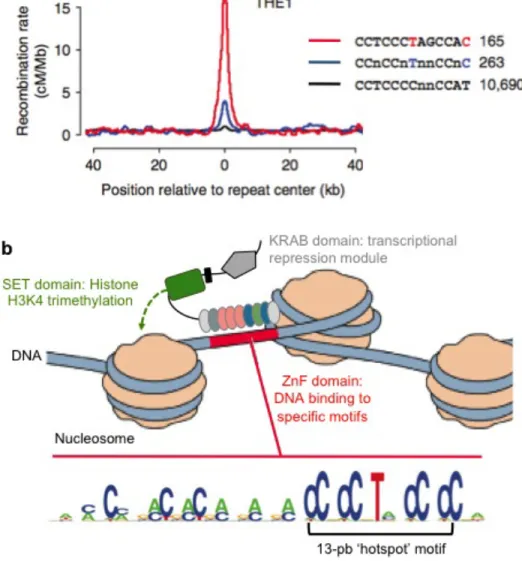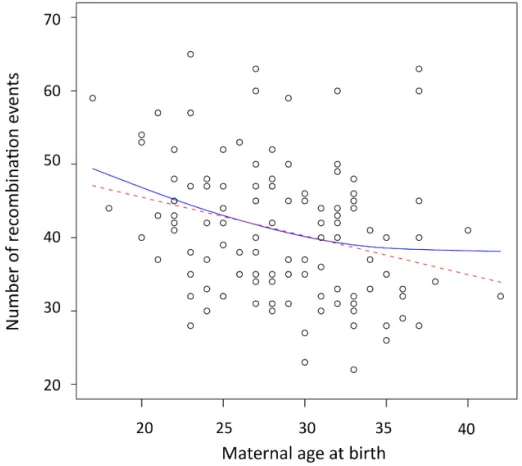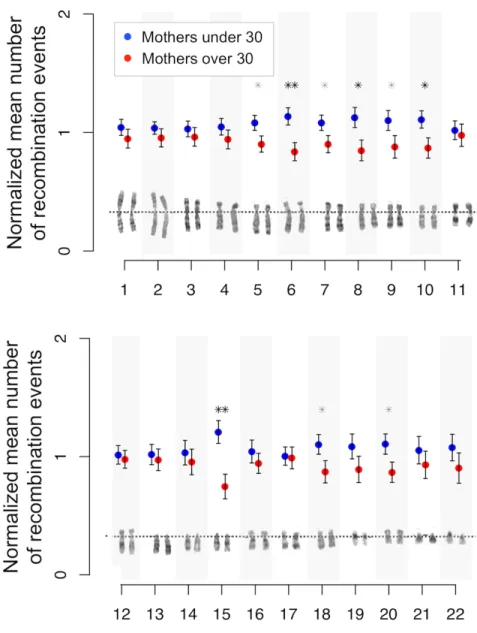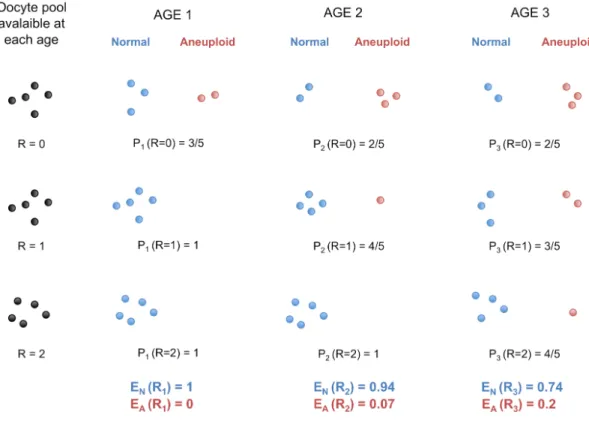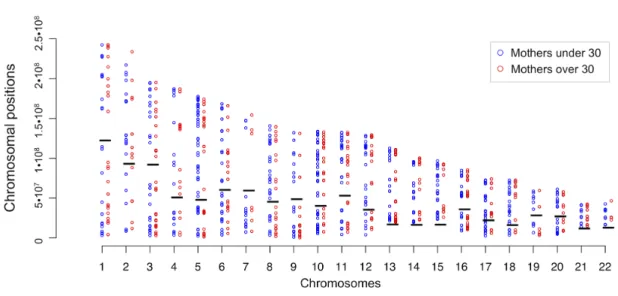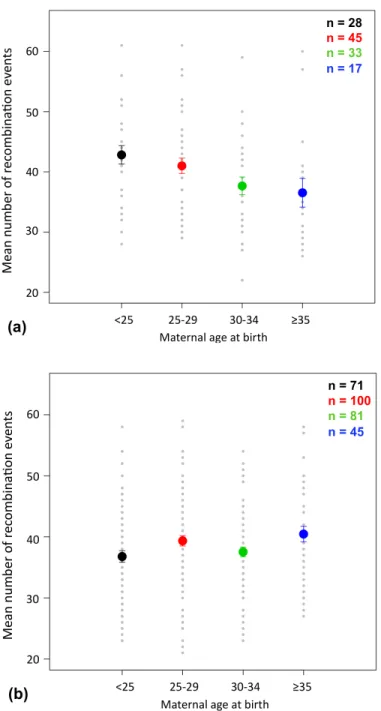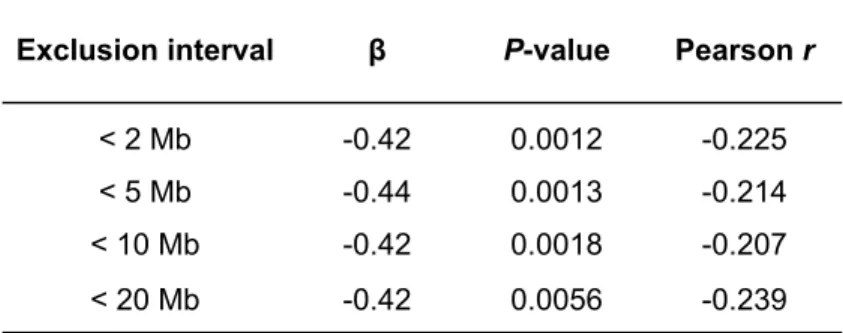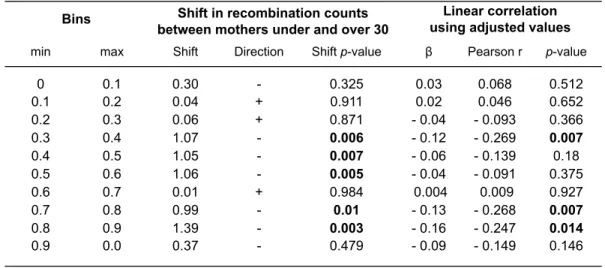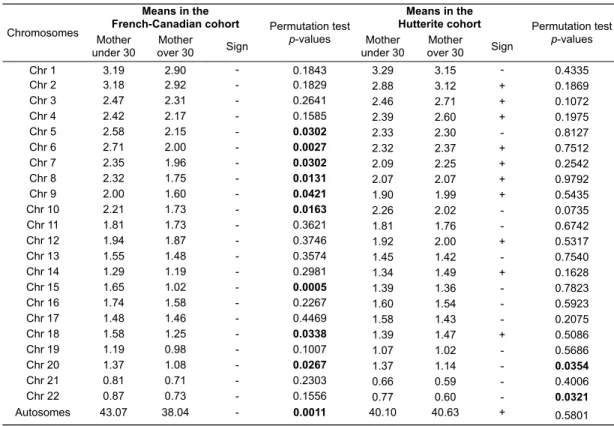Genomic variation in recombination patterns:
implications for disease and cancer
par Julie Hussin
département de biochimie Faculté de médecine
Thèse présentée à la Faculté des études supérieures en vue de l’obtention du grade de Ph. D.
en Bio-‐informatique Février 2013 © Julie Hussin, 2013
Université de Montréal Faculté des études supérieures
Cette thèse intitulée :
Genomic variation in recombination patterns:
implications for disease and cancer
présentée par : Julie Hussin
évaluée par un jury composé des personnes suivantes: Sylvie Mader
président-‐rapporteur
Philip Awadalla
directeur de recherche
Guy Rouleau
membre du jury
Gil McVean
examinateur externe
Guillaume Lettre
représentant du doyen de la FES
Abstract
The intergenerational mixing of DNA through meiotic recombination of homologous chromosomes is, along with mutation, a major mechanism generating diversity and driving the evolution of genomes. In this thesis, I use bioinformatics and statistical approaches to analyse modern genomic data in order to study the implication of meiotic recombination in human disease. First, using high-‐density genotyping data from French-‐Canadian families, we studied sex-‐ and age-‐specific effects on recombination patterns. These analyses lead to the first observation of a significant decrease in recombination rates with advancing maternal age in humans, with potential implications for understanding trisomic conceptions. Second, using next-‐ generation sequencing of exomes from families of children with leukemia, we discovered unusual distributions of recombination breakpoints in some leukemia patients, which implicates PRDM9, a protein involved in defining the location of recombination breakpoints, in leukemogenesis. Third, using single nucleotide polymorphisms (SNPs) called from RNA sequencing data, we present a detailed comparison of the mutational burden between high and low recombining regions in the human genome. We further show that the mutational load in regions of low recombination at the individual level varies among human populations. In analysing genomic data to study recombination in population and disease cohorts, this work improves our understanding of how recombination impacts human health. Furthermore, these results provide insights on how variation in recombination modulates the expression of phenotypes in humans.
Keywords : genetic recombination, sequencing, PRDM9, population genetics, leukemia
Résumé
Durant la méiose, il se produit des échanges réciproques entre fragments de chromosomes homologues par recombinaison génétique. Les chromosomes parentaux ainsi modifiés donnent naissance à des gamètes uniques. En redistribuant les mutations génétiques pour générer de nouvelles combinaisons, ce processus est à l’origine de la diversité haplotypique dans la population. Dans cette thèse, je présente des résultats décrivant l’implication de la recombinaison méiotique dans les maladies chez l’humain. Premièrement, l'analyse statistique de données de génotypage de familles québécoises démontre une importante hétérogénéité individuelle et sexe-‐spécifique des taux de recombinaisons. Pour la première fois chez l’humain, nous avons observé que le taux de recombinaison maternel diminue avec l'âge de la mère, un phénomène potentiellement impliqué dans la régulation du taux d’aneuploïdie associé à l’âge maternel. Ensuite, grâce à l’analyse de données de séquençage d’exomes de patients atteints de leucémie et de ceux de leurs parents, nous avons découvert une localisation anormale des évènements de recombinaison chez les enfants leucémiques. Le gène PRDM9, principal déterminant de la localisation des recombinaisons chez l’humain, présente des formes alléliques rares dans ces familles. Finalement, en utilisant un large spectre de variants génétiques identifiés dans les transcriptomes d’individus Canadiens Français, nous avons étudié et comparé le fardeau génétique présent dans les régions génomiques à haut et à faible taux de recombinaison. Le fardeau génétique est substantiellement plus élevé dans les régions à faible taux de recombinaison et nous démontrons qu’au niveau individuel, ce fardeau varie selon la population humaine. Grâce à l’utilisation de données génomiques de pointe pour étudier la recombinaison dans des cohortes populationnelles et médicales, ce travail démontre de quelle façon la recombinaison peut affecter la santé des individus.
Mots clés: recombinaison génétique, séquençage, PRDM9, génétique des populations, leucémie
Table of Content
ABSTRACT
III
RÉSUMÉ
IV
TABLE OF CONTENT
VI
LIST OF FIGURES
XI
LIST OF TABLES
XIV
ABBREVIATIONS AND ACRONYMS
XVI
ACKNOWLEDGMENTS
XVIII
CHAPTER I: INTRODUCTION
1
Introduction 2
I. Genome Evolution and Variation in Recombination 4
1. The Evolutionary Advantage of Recombination 4
2. Intragenomic Variation in Recombination and Natural Selection 8
3. Detecting Recombination in Human Data 10
4. Patterns of Variation in Human Recombination 16
II. Molecular Players and Genomic Disorders 24
1. Meiosis, Recombination and Fertility in Humans 25 2. The Crossover Pathways, the Holliday Junction and Aneuploidies 28 3. The Non-‐Crossover Pathway and Gene Conversion 30
5. Somatic Recombination, Combined Immunodeficiencies and Cancers 35
Research Questions and Thesis Outline 43
CHAPTER II: AGE-‐DEPENDENT RECOMBINATION RATES IN HUMAN
PEDIGREES
45
Authors’ contribution 46 Acknowledgments 46 Abstract 47 Author summary 48 Introduction 49 Results 52Significant Variation in Fine-‐Scale Recombination Patterns 52
Genome-‐Wide Negative Maternal Age Effect 53
Evaluating Maternal Age Effects along Chromosomal Arms 55 Phenotypes Show No Association with Maternal Age and Recombination 57
Comparisons with previous studies in humans 59
Discussion 62
Material and Methods 68
Ethics Statement 68
Cohort Description and Genomic Data 68
Algorithm to Call Recombination Events 68
Fine-‐scale Recombination Patterns Among Individuals 70
Correlation between recombination and maternal age across transmissions 70
Chromosome-‐Specific Effects 71
Maternal age effect and clinical phenotype 73 Factors influencing power to detect the maternal age effect 73 Analyses of the maternal age effect on recombination found in Hutterites 74
Supplementary Methods 76
Supplementary Figures and Tables 82
CHAPTER III: RARE ALLELIC FORMS OF PRDM9 ASSOCIATED WITH
CHILDHOOD LEUKEMOGENESIS
89
Authors’ contribution 90 Acknowledgments 91 Abstract 92 Introduction 93 Results 96The ALL family quartet 96
De novo mutation and recombination events 98
Characterising PRDM9 in the ALL family quartet 101
Association between PRDM9 and ALL in parents 102
Replication in a B-‐ALL patient cohort 103
PRDM9 binding motifs and ALL translocations 106
Discussion 110
Material and Methods 115
Datasets 115
Exome Sequencing in the FCALL cohort 116
Genome-‐wide SNP Arrays 116
PRDM9 Zinc Fingers Typing in Short Read Data 118
Sanger Sequencing of PRDM9 ZnF Alleles 119
Association Testing and Ancestry Analyses 119
Genomic Motif Search 120
Mapping PRDM9 binding motifs within the ALL gene list 121
Translocation Data 122
Data Access 122
Supplementary Methods 123
Supplementary Results 127
Supplementary Figures and Tables 134
CHAPTER IV: IMPACT OF VARIABLE RECOMBINATION ON HUMAN
MUTATION LOAD
159
Author’s contribution 160 Acknowledgments 160 Abstract 161 Introduction 162 Results 165The French-‐Canadian Study Population 165
Recombination Rates, Coldspots and High Recombination Regions 165 Increased Diversity at Nonsynonymous Positions in Coldspots 167 Enrichment of Highly Conserved Mutations in Coldspots 171
Frequency-‐based Measures of Mutational Load 174
Robustness to Potential Confounding Factors 176
Coldspot Mutational Load in Regional Populations and Per Individual 178 Increased linkage of rare and deleterious variants in coldspots 181
Replication in the 1000 Genomes Project Populations 182
Discussion 186
Material and Methods 191
Ethics Statement 191
Cohort Description 191
Genomic data: RNA-‐sequencing and Genotyping 192
Estimation of Recombination Rates and Genetic Map Construction 193
RNA-‐seq SNPs annotation and exon inclusion 194
Mutational Load and Odds Ratios 197
Extracting Mini-‐Haplotypes from Mapped Paired-‐end Reads 198 SNP data in Populations from The 1000 Genomes Project 199
Supplementary Results 200
Supplementary Figures and Tables 203
CHAPTER V: DISCUSSION
213
Discussion and Perspectives 214
Disease, Maternal Effects and Parental Genetics 214
PRDM9 Function and Beyond 217
PRDM9 and Allelic Incompatibilities 220
A Model of Heredity for Childhood Leukemia 223
Adaptative Patterns of Linkage 225
Mutation and Recombination 227
Conclusion 230
List of Figures
CHAPTER I
Figure 1. Effect of recombination on accumulation of favorable and deleterious
alleles. ... 6
Figure 2. Methods to infer recombination events occuring within various time frame captured. ... 11
Figure 3. Recombination hotspot motif and PRDM9. ... 17
Figure 4. Structure and frequencies of human PRDM9 ZnF alleles. ... 23
Figure 5. Schematic representation of the meiotic recombination process. ... 25
Figure 6. Genomic rearrangements mediated by recombination processes ... 33
CHAPITRE II
Figure 1. Negative correlation between the maternal age at birth and the number of recombination events ... 54Figure 2. Chromosome-‐specific effects ... 56
Figure 3. Distribution of recombination events along chromosomal arms. ... 58
Figure 4. Protection against non-‐disjunction may be reduced as women ages. .... 66
Figure S1. Recombination hotspots and maternal age ... 82
Figure S2. Maternal age effect in the Hutterite study. ... 83
Figure S3. Maternal age effect with age categories ... 84
Figure 1. The ALL quartet family pedigree ... 97
Figure 2. Map of recombinations events and hotspot usage in the ALL quartet .... 99
Figure 3. Excess of rare PRDM9 alleles in parents from the FCALL cohort ... 104
Figure 4. PRDM9 C binding motif in the MLL breakpoint cluster region. ... 109
Figure S1. Identification of a de novo mutation in SMAD6 on chromosome 15. ... 134
Figure S2. Mean recombination rate in the parents from the ALL quartet and the FC cohort. ... 135
Figure S3. Genetic Ancestry of the ALL Quartet Parents. ... 136
Figure S4. PRDM9 ZnF alleles in 27 unrelated Moroccan individuals. ... 137
Figure S5. Proportion of recombination events called near PRDM9 binding motifs. ... 138
Figure S6. ZnF repeat types of PRDM9 alleles. ... 139
Figure S7. Genetic ancestry of parents from the FCALL cohort. ... 140
Figure S8. Genetic ancestry of SJDALL patients. ... 141
Figure S9. PCR primers used for amplifying and sequencing PRDM9 ZnF alleles. . 142
Figure S10. Chromosomal crossover breakpoints and shared haplotypes in the ALL quartet. ... 143
CHAPITRE IV
Figure 1. CARTaGENE sampling in three regional populations of Quebec ... 166Figure 2. Patterns of linkage disequilibrium and recombination in French-‐ Canadians. ... 168
Figure 3. Comparison of diversity and functional classes of mutations between coldspots and HRRs. ... 170 Figure 4. Comparison of conservation scores between coldspots and HRRs exomic positions and SNPs. ... 173 Figure 5. Differential mutational load based on frequency-‐based statistics ... 175 Figure 6. Differential mutational load in CaG regional populations ... 179 Figure 7. Differential mutational load in populations from The 1000 Genomes Project. ... 184 Figure 8. Distribution of individuals Odds Ratios (indOR). ... 185 Figure S1. Genetic differentiation between MTL, SAG and CEU ... 203 Figure S2. Illustration of the definition of coldspot (CS), hotspot (HS) and high recombination regions (HRRs). ... 204 Figure S3. Uncorrected odds ratios (ORs) for SNPs compared to ORs for exomic positions for conservation categories. ... 205 Figure S4. Calling “mini-‐haplotypes” from sequencing data. ... 206
CHAPITRE V
Figure 1. Proposed model of heredity for childhood acute lymphoblastic leukemia. ... 224
List of Tables
CHAPTER II
Table S1. Significant variation among autosomes in number of recombination events among male and female transmissions. ... 85 Table S2. Exclusion of double recombinants. ... 86 Table S3. Correlations between recombination counts and maternal age along chromosomal arms. ... 87 Table S4. Mean number of recombination events among maternal transmissions for each autosome in the French-‐Canadian and Hutterite studies. ... 88
CHAPTER III
Table 1. Replication of the association between PRDM9 k-‐finger alleles and in patients from St. Jude ALL cohort ... 105 Table 2. PRDM9 alleles binding motifs in the Human Reference Genome. ... 107 Table S1. Coverage and SNPs statistics in the ALL quartet. ... 146 Table S2. Number of maternal and paternal recombination events per
chromosome. ... 147 Table S3. PRDM9 alleles in the ALL quartet and 12 ALL trios based on read data and re-‐sequencing. ... 148 Table S4. PRDM9 alleles in an additional 10 ALL trios with B-‐ALL children based on read data. ... 149 Table S5. PRDM9 alleles in 76 French-‐Canadian individuals. ... 150 Table S6. B-‐ALL molecular subtypes for the 24 patients included in this study. ... 151
Table S7. PRDM9 alleles in 50 children from SJDALL cohort based on read data. 152 Table S8: Most frequent translocations and fusion genes in ALL. ... 154 Table S9. PRDM9 alleles binding motifs in unique and repetitive DNA ... 156 Table S10. Data and analyses performed in this study. ... 157
CHAPTER IV
Table 1. Per-‐individual differential mutational loads ... 180 Table 2. Differential load of mini-‐haplotypes in coldspots (CS) and HRRs. ... 182 Table S1. Distribution of Coldspots (CS) and High Recombination Regions (HRR) genome-‐wide and in analysed exons. ... 207 Table S2. Summary of linear models evaluating the correlation between
recombination rates per exon and various variables. ... 208 Table S3. Comparison between conservation scores and functional annotations 209 Table S4. Robustness of the effect to recombination parameters. ... 210 Table S5. Robustness of the effect to GC-‐content and gene expression levels. .... 211 Table S6. Effective population size estimation based on inferred recombination rates. ... 212 Table S7. Mini-‐haplotype analysis in the 1000 Genomes Project Populations. .... 212
CHAPTER V
Table 1. Supplementary data on PRDM9 association with pre-‐B and pre-‐T ALL. . 216 Table 2. SNPs within sequences matching the common allele binding motif (A) and the C-‐type allele binding motif (C). ... 222
Abbreviations and Acronyms
ACA : Acadians of Quebec
ALL : Acute Lymphoblastic leukemia B-‐ALL : B-‐cell precursor ALL
BCR : Breakpoin Cluster Region ANOVA : Analysis of variance CaG : CARTaGENE
CEU : HapMap population from Utah residents with Northern and Western European ancestry
CEPH: Centre d’Etude du Polymorphisme Humain CI : Confidence Intervals CVD : Cardio-‐Vascular Disease CNO : North Shore Region cM : centiMorgan
CMT1A : Charcot-‐Marie Tooth Disease type 1A
DGS : DiGeorge syndrome dN : rate of nonsynonymous
substitution
DNA : Deoxyribonucleic acid
dS : rate of synonymous substitution
DSB : Double-‐Strand Break FAB-‐L1 : French American British
subtype L1
FC : French-‐Canadian
FoSTeS : Fork Stalling and Template Switching
FRS : Framingham Risk Score GAS : Gaspesia Region Gb : Gigabase
GC : Guanine-‐Cytosine
gBGC : GC-‐Biaised Gene Conversion H3K4me3 : Histone H3 lysine 4
trimethylation
hg18 : March 2006 Human Genome Version
hg19 : February 2009 Human Genome Version
HGDP : Human Genome Diversity Project
HJ : Holliday Junction
HLA : human leukocyte antigen HNPP : hereditary neuropathy with
liability to pressure palsies
HRR : High Recombination Regions HS: Hotspot
HWE : Hardy-‐Weinberg equilibrium IgH : Immunoglobulin Heavy chain indOR : Odds Ratio per individual Kb : Kilobase
L1 : Long Interspersed Element 1 LCR : Low Copy Repeats
LD : Linkage Disequilibrium
LS-‐CHD : Left-‐Sided Congenital Heart Disease
LOH : Loss of heterozigosity LOY : Loyalists of Quebec MAF : Minor Allele Frequency Mb : Megabase
MMBIR : Microhomology-‐Mediated Break-‐Induced Replication
MRCA : Most Recent Common Ancestor
MTL : Montreal Area NA : non-‐applicable
NAHR : Non-‐Allelic Homologous Recombination
NCBI : National Center for Biotechnology Information Ne : Effective population size
NF1 : Neurofibromatosis type 1 NGS : Next-‐Generation Sequencing NHEJ : Non-‐homologous End-‐Joining ns : non-‐significant
OR : Odds Ratio
PCA : Principal Component Analysis PCR : Polymerase Chain Reaction PHD : Plant Homeodomain
Ph+ : Philadelphia chromosome positif PWS : Prader-‐Willi syndrome
QCC : Quebec City
REML : Restricted maximum likelihood RNA : Ribonucleic acid
RNAseq : RNA sequencing
RPQ : Reference Panel of Quebec RSS : Recombination Signal Sequence SAG : Sagnenay Region
SC : Synaptonemal Complex SCID : Severe Combined
Immunodeficiency
SDSA : Synthesis-‐Dependent Strand-‐ Annealing
SJ : St. Jude Children’s Research Hospital
SMA : Spinal Muscular Atrophy SMS : Smith-‐Magenis syndrome SNP : single-‐nucleotide polymorphism T-‐ALL : T-‐cell precursor ALL
TCR : T-‐cell receptor
TSS : Transcription Starting Site UCSC : University of California, Santa
Cruz
WBS : Williams-‐Beuren syndrome YRI : HapMap Yoruba population from
Ibadan, Nigeria ZnF : Zinc Fingers
Acknowledgments
It is my great pleasure to acknowledge all of those who have contributed in many ways to make this thesis possible.
First of all, I wish to express my endless thanks to my advisor, Philip Awadalla. I am grateful for his expert and valuable guidance and constant encouragement, for his enthusiasm and inspiring vision. I particularly want to thank him for giving me the opportunity to join his laboratory and work on diverse and exciting projects, as it was him who convinced me to pursue doctoral studies.
I would also like to thank all present and past members of the Awadalla lab ‘family’, for their help and friendship. In particular, I would like to thank Jacklyn Quinlan and Youssef Idaghdour, with whom I not only shared an office, but also times of laughters, panic and philosophical reflections. I also thank Ferran Casals and Elias Gbeha, for their valuable help with experimental work, and Vanessa Bruat, Thibault de Malliard and Jean-‐Christophe Grenier, for their great work and technical assistance.
I deeply thank my great friend and colleague, Claude Bherer, for always being available to talk endlessly about life and science, for spending hours questioning me about my ideas and for generously sharing hers.
I would like to thank all my professors and colleagues from the Bioinformatics program at University of Montreal. Particularly, I warmly thank Marie Pier Scott-‐ Boyer : we went through so much together during all these years as undergraduate and graduate students. I am also glad to acknowledge the help I received from the administrative staff at Ste-‐Justine and at the biochemistry department. Elaine Meunier, Alida Hounyovi, Sandy Lalonde and Dominika Kozubska deserve special mention for their kind assistance.
I am very grateful to Sylvie Mader, Gil McVean and Guy Rouleau for taking the time to review this thesis. I also wish to acknowledge Miklos Csuros, François Major, Luis Barreiro, Mark Samuels and Marie-‐Helene Roy-‐Gagnon for being on my thesis commitees and for providing useful suggestions and comments.
My sincere thanks go to Gregor Andelfinger, Daniel Sinnett and Charles Mullighan and their research teams, for allowing access to their disease cohorts from Ste-‐ Justine and St. Jude children’s hospitals. In addition, I share the credit of my work with all my co-‐authors on the manuscripts presented in this thesis, and I would like to thank all of the researchers on whose work I was able to build.
I take this opportunity to sincerely acknowledge all patients and their families that participated in these studies, for their generosity in sharing their informations and biologicals to improve health research. I also thank the volunteers in Quebec that participated in the Cartagene project and all members of the Cartagene team, who make this great project a reality.
It is with immense gratitude that I thank my fiancé, Olivier Gandouet, for his unceasing encouragements and patience, and for providing brillant solutions to the many problems I encountered. This thesis would not have been possible without his love and support. I would also like to thank all my family in Belgium, for believing in me since I was a little girl. I’m also very grateful to my dearest friends, Elina Betman, Emy Behmoaram, Daphné Bui, Jade Damdjee and Nadine El Kurdi, for always being understanding and supportive in all my excitements, struggles and frustrations. Finally, I would like to express my eternal appreciation towards the two most wonderful researchers I know : my parents. Towards my father, Jules Beckers, who left much too early, but who continues to be my source of inspiration in my research and in my life. Towards my mother, Véronique Hussin, who has always been my role model and who has instilled in me confidence and the love of science. Thank you for all your precious advice.
I ackowledge the financial support from biT excellence scholarships, Natural Sciences and Engineering Research Council of Canada (NSERC), the Foundation of Stars, le Réseau de médecine génétique appliquée (RMGA), la Faculté des études supérieures et postdoctorale de l’Université de Montréal (FESP).
I dedicate this work to the memory of my father, Jules Beckers Only through my future work will I be able to properly thank him Je t’aime Papa
CHAPTER I: Introduction
THE IMPACT OF RECOMBINATION
IN HUMAN DISEASE
INTRODUCTION
« Ce qui donne à un individu sa valeur génétique, ce n'est pas la qualité propre de ses gènes. C'est qu'il n'a pas la même collection de gènes que les autres. » Sciences de la vie et société – 1980 François Jacob (1920-‐2013)
Although mutation is the ultimate source of genetic variation, meiotic recombination is a contributing mechanism playing a powerful role in driving the evolution of genome structure by generating haplotypic diversity. The recombinational process creates new combinations of parental genetic material and thus enables every child to receive a unique mosaic of parental pairs of chromosomes, drawn from an extremely large number of possibilities. Furthermore, mutations involving large insertions and deletions, transpositions and rearrangements mainly arise through recombination mechanisms. It follows that, in breaking down parental associations between variants, recombination allows phenotypic variability across generations. Natural selection acting on novel haplotypes likely favors recombination among lineages, depending on variable environmental factors or life histories. However, tight regulation of the mutational and recombinational processes is needed for the maintenance of genome stability in somatic and germinal cells, as multicellular species experience a very large number of cell divisions per generation resulting in their genomes being particularly prone to errors.
Substantial variation in the rate and distribution of crossovers has been found between and among species, genders, ages, populations and individuals, within and among chromosomes, at a megabase and kilobase scales. In mammals, the distribution of crossovers along the genome is known to vary, and substantial regions of DNA with unusually low recombination are observed, known as coldspots,
while highly localized peaks of recombination, known as hotspots, are also seen. The histone modifier PRDM9 has been identified as a major determinant of the location of recombination hotspots in mammals (Baudat et al. 2010). However, comparing recombination landscapes between primate species shows that hotspots are not conserved and fine-‐scale recombination rates are markedly different, suggesting a rapid turnover of the recombination landscape on an evolutionary scale. Among humans, variation in fine-‐scale rates of recombination was observed between populations and individuals and important sex-‐differences in recombination rates exist. Therefore, many different selective forces may be acting on recombination rates over time. Since natural selection will not act independently on mutations at linked loci, the rate of adaptation will depend on the local mutation and recombination rates.
What causes variation in recombination rates to be so widespread, and what are the consequences for the human genome, remain open questions with important implications for understanding human disease and adaptation. The goal of this chapter is to review work that considers how recombination processes in humans influence disease. Before addressing the potential molecular roles of recombination in human disease, I will address the question of why is recombination adaptative and what benefits and consequences it has on genome evolution. I will then review the approaches available for estimating recombination rates in natural populations and detail the various levels of variation observed within and between genomes. I will further describe the molecular players involved in meiotic and somatic processes of recombination, influencing genome stability. These processes altogether influence human diseases, and pediatric disorders in particular, and the present state of knowledge linking disease and recombination is reviewed.
I. GENOME EVOLUTION AND VARIATION IN RECOMBINATION
Meiotic recombination is the process by which two genomes fuse to produce cells that contain a mixture of genes, before separating as a result of chromosome segregation. Errors in recombination affect genomic integrity in a critical manner, the frequency of crossover should therefore be tighly regulated. However, extensive variation in recombination rates has been observed at all scales, within and between genomes. In this chapter section, I discuss the effects of this variation on genome evolution and how it modulates the efficacy of selection. The existing methods to detect recombination will be presented, followed by a description of the variation of recombination that has been observed in humans.
1. The Evolutionary Advantage of Recombination
How recombination evolved initially and why it has been maintained are critical to understanding why sexual reproduction is so widespread in our world. Producing offspring sexually has a two-‐fold cost in fitness, because only females are capable of bearing youngs, such that male and female individuals do not contribute resources to the offspring equally (Lehtonen et al. 2012). Furthermore, only half the genes in the offspring are from each parent, who survived to reproductive age. As these mates have genomes that proved themselves successful in the current environment, it is puzzling that they would shuffle their genotypes by recombination and risk creating genomes with lower fitness. In line with this idea, there is theoritical evidence that at loci that control recombination, alleles that decrease it are favored (Kimura 1956; Lewontin 1971). Selection should therefore operate to eliminate sexual recombination in a population. However, and despite the additional cost of securing a mate to reproduce, the vast majority of species reproduce sexually (Engelstadter 2008), with varying levels of genetic mixing (Awadalla 2003). This is known as the paradox of sex (Otto and Lenormand 2002).
A direct effect of genetic recombination, that might explain its origin, is the transfer of genetic elements from one genomic background to another, allowing for the spread of genetic elements such as phage, bacterial plasmids or transposable elements (Otto and Lenormand 2002). Another molecular phenomenon that could account for the origin of genetic exchange is that it is associated with the repair of DNA damage (Bernstein et al. 1981). These associations might explain the origin of sex and recombination, but are unlikely to explain why recombination was not eliminated by natural selection, despite its costs.
Evolutionary explanations for recombination, stating that recombination exists because mixing genetic material from two individuals is by itself beneficial, were first presented in the classical work of Fisher (1930) and Muller (1932). These authors described that favorable mutants which arise in different genomes can be combined into the same genome by recombination, which favors the fixation of beneficial alleles in populations with recombination. In a population with no recombination, two favorable mutations will succeed in fixing only if they appeared on the same genetic background, i.e. if the second mutation occurs in a descendant of the individual in which the first mutation arose. Otherwise, only one can ultimately be fixed and most of the new favorable mutations will be lost, slowing down the rate of evolution. These concepts were further extended by Hill and Roberston to take into account the effect of genetic drift, linkage and selection (Hill and Robertson 1966). They showed that, with no recombination, beneficial mutations at linked loci and occurring on different genetic background will interfere with one another’s fixation, thereby decreasing the effectiveness of selection. This is known as “Hill-‐Robertson interference” (Figure 1a). H.J. Muller introduced a similar effect, known as “Muller’s ratchet”, to describe how genomes of an asexual population accumulate deleterious mutations in an irreversible manner (Muller 1964). Muller considered the case of deleterious alleles instead of advantageous ones, and pointed out that in the absence of recombination, natural selection could never reduce the number of linked deleterious alleles. This is because repeated losses of chromosomes with the
Figure 1. Effect of recombination on accumulation of favorable and deleterious alleles.
(a) The Hill–Robertson interference. Three linked sites are considered with nucleotide a, b and c. The new alleles A and B are advantageous and provide fitness increases of 10% and 0.1%, respectively, whereas C is neutral. Without recombination, A is rapidly fixed in the population because of its large fitness advantage, along with b and c due to genetic hitchhiking. With recombination, the fittest combinations ABc and ABC can be generated and become predominant in the population [redrawn from (Marais and Charlesworth 2003)]. (b) Muller’s ratchet. The top diagram shows the initial distribution of individuals with 0, 1, 2, … slightly deleterious alleles in a population without recombination at equilibrium. The middle diagram shows the same population when the fittest class is lost by chance. With no recombination and no back mutation, this class can never be recovered. The whole distribution shift to the right after the ratchet “has clicked round one notch” (Muller 1964). The process is then repeated (lower diagram), leading to an increase in mutational load and decrease in fitness.
a b c a b C A b c a B c +10% +0.1% A b c A B c A B C Without recombination With recombination Favorable allele Neutral allele Mutations
The Hill–Robertson effect
a
!" #" $" %" &" '" (" )" *" +" #!"
!" #" $" %" &" '" (" )" *" +" #!"
!" #" $" %" &" '" (" )" *" +" #!" Number of slightly deleterious mutations in a
non-recombining region
Muller’s Ratchet
b
Initial distribution of mutations
Loss of the fittest class (with 0 mutation)
Loss of the fittest class (with 1 mutation)
Shift to a new equilibrium
Shift to a new equilibrium
smallest number of mutations will lead to a gradual accumulation of deleterious mutations (Figure 1b). Genomic regions with recombination are far less subject to this effect, since mutations at different sites can disentangle themselves from initial chance associations. Muller’s ratchet mechanism thus predicts an increase in the average number of deleterious alleles in genomic regions with no recombination. Following these seminal articles, several authors presented computer simulations to verify the theoritical models (Felsenstein 1974; Birky and Walsh 1988; McVean and Charlesworth 2000; Gordo et al. 2002), confirming that recombination should speed up the response to selection in a population, that slightly deleterious mutations should accumulate in non-‐recombining regions and that the chance of fixation of a positively selected new mutation is greatly reduced. J. Felsenstein stated that this impact on mutational load may be the most quantitatively important evolutionary effect of recombination (Felsenstein 1974), since there must be far more deleterious alleles occurring than beneficial ones.
There are, however, conditions under which uncoupling variants at different sites is not advantageous. In the absence of linkage, genes are already well mixed in the population and shuffling genomes further by recombination will have no effect on the population fitness. Therefore, the advantageous effect of recombination will depend on the patterns of linkage between loci that have been built over time. The actual linkage disequilibrium patterns may therefore be of major importance in determining if and where natural selection will act. Furthermore, recombination will be advantageous only if the associations between loci are negative, when favorable and deleterious alleles are linked to each other. Linkage disequilibrium may also be positive, when favorable (or deleterious) alleles are linked to one another, a scenario where recombination is not advantageous, because it slows down the fixation of beneficial mutations (or the removal of detrimental mutations).
2. Intragenomic Variation in Recombination and Natural Selection
Within nuclear genomes of eukaryotes, considerable variation in the local rate of recombination has been observed from genetic data. At a genomic-‐scale, at least one crossover event per autosome is necessary and the average recombination rate is negatively correlated with genome size (Awadalla 2003). Sex chromosomes harbor large regions with increased recombination, such as pseudoautosomal regions, and regions depleted of recombination, such as for the mammalian Y chromosome. Broad-‐scale variation at the chromosomal level has been identified in mammals: centromeric regions show consistently low recombination rates whereas telomeric regions tend to have particularly high rates (Choo 1998; Jensen-‐Seaman et al. 2004).
Furthermore, factors such as DNA methylation, genetic imprinting and germline transcription correlate with large scale recombination rates (Lercher and Hurst 2003; Sigurdsson et al. 2009; McVicker and Green 2010). At a finer scale, it is now well described that recombination rates are not uniformly distributed throughout a chromosome, and occur largely in recombination hotspots of 1-‐2Kb that exhibit a rate of recombination up to 100-‐fold higher than the genome average.
Empirical estimation of the local recombination rate have prompted researchers to study the consequences of recombination on genetic diversity since the late 1980s, after the introduction of the concept of hitchhiking of beneficial mutations by positive selection (Smith and Haigh 1974). A positive correlation between local recombination rate and level of silent variability was found, originally described in
Drosophila (Aguade et al. 1989; Begun and Aquadro 1992). A decade later, it was
established that genomic regions with essentially no recombination deteriorate faster than recombining regions (Charlesworth and Charlesworth 2000), forming partial evidence that suppression of recombination per se reduces the efficacy of selection. However, there is little empirical evidence that variation in the recombination rate leads to significant variation in the efficacy of selection across the genome (Webster and Hurst 2012).
Studies have investigated this question by evaluating the relationship of local recombination rates and measures of the rate of adaptation, such as as dN/dS and
codon usage bias (Yang and Nielsen 1998; Hey and Kliman 2002). Codon usage bias measures the proportion of “preferred” codons, coded by the most abundant tRNAs, and is used as an estimate of selection in species with large population size. It was found to correlate positively with recombination rate in Drosophila and
Caenorhabditis elegans. However, recombination rates correlate with content in
guanine and cytosine (GC-‐content) in many taxa, potentially explaining the effect of recombination on codon usage bias (Marais et al. 2001). The ratio of the rate of nonsynonymous substitution on the rate of synonymous substitution, dN/dS, reflects
the selective forces acting on non-‐silent sites relative to silent ones that are much less constrained. When selection is acting, dN/dS departs from 1: it is higher if most
nonsynonymous sites are beneficial, or reduced if most sites are deleterious. Because both adaptation and purifying selection may occur at many genes, it is difficult to know a priori whether a positive or negative correlation between dN/dS
and recombination rate is expected. Conflicting results about the effect of recombination rates on dN/dS have been found in Drosophila (Larracuente et al.
2008) and, in humans, dN/dS is constant across crossover rate categories (Bullaughey
et al. 2008).
However, many studies have shown that recombination rates are different between species, even closely related ones, questioning whether the use of dN/dS for
examining the impact of recombination on the efficacy of selection is a satisfactory approach. Although the average number of recombination events per chromosome is likely conserved across a wide array of species, there is substantial variation in fine-‐scale recombination rates among multicellular organisms (Awadalla 2003; Wilfert et al. 2007). Furthermore, although humans and chimpanzees share around 99% of their genome, the precise location of recombination hotspots is not conserved between them, suggesting a rapid turnover of the recombination landscape between closely related species (Ptak et al. 2005; Auton et al. 2012). If the
local recombination rate is fast evolving, currently observed recombination rates are unlikely to reflect the recombinational history that may have diverged since the reproductive isolation of the two species.
3. Detecting Recombination in Human Data
Recombination rates can be detected directly, by cytological approaches and by sperm typing methods, or indirectly, by building genetic maps using genetic data from pedigrees or unrelated individuals from a population (Figure 2). The recombination rate, r, is usually measured in terms of the expected number of recombination events per generation between two loci, expressed in centimorgan (cM) units, which is defined as a 1% chance that two loci will be separated by a recombination event in one meiosis. Genetic maps define the linear order of markers along a chromosome, with distances between pairs of markers measured in cM. Commonly used genetic markers in human genetics include microsatellite markers and single-‐nucleotide polymorphisms (SNPs). SNPs became the markers of choice for constructing genetic maps, their greater density – more than four per Kb (The 1000 Genomes Project Consortium 2010), compared to the highly polymorphic microsatellite markers – around one every 15Kb (Subramanian et al. 2003), compensate for the smaller amount of information per SNP by creating local haplotypes that have greater linkage information content.
Direct approaches : Cytogenetics and Sperm Typing
The direct approches to study recombination examine the direct result of meiosis, at the individual level (Figure 2d). Cytological approaches aim at analysing cells at specific meiotic time points to examine chiasma, the physical manifestation of recombination, and crossover-‐associated proteins (Figure 2e). These approaches allowed for detailed comparisons of crossover frequency among individuals in a chromosome-‐specific manner, leading to primary observations that each chromosome has at least one crossover, that females have more crossovers than males and that the presence of one crossover inhibits the formation of a second one
